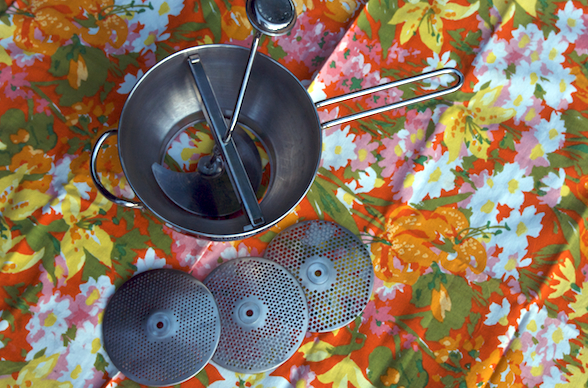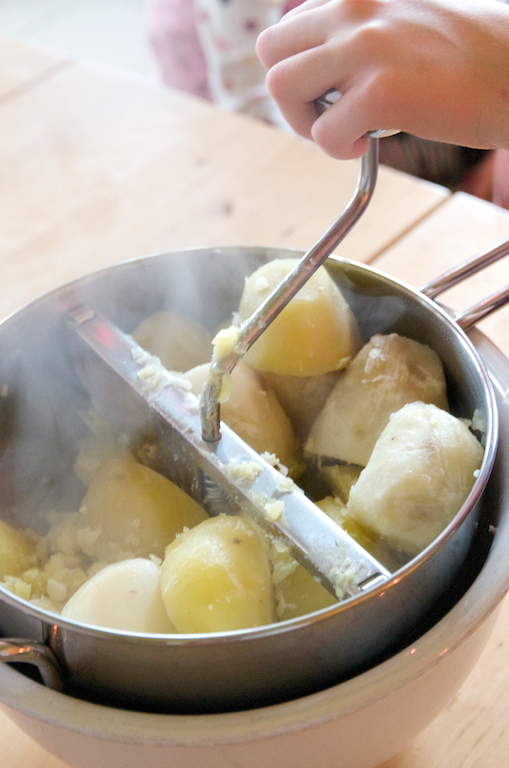The One. The Only. The Irreplaceable Food Mill
The first serious cookbook I ever acquired was The Martha Stewart Cookbook. Her recipe for a spicy corn chowder was among the first dishes I ever attempted in my teensy NYC studio apartment kitchen. That recipe also began my collection of serious cooking tools. The recipe calls for the use of a food mill to separate the soft starchy corn from the tough outside hull of the kernel. This begs the question, “What the hell is a food mill?”
Undaunted, I traipsed off to the nearest store selling cooking miscellanea. I asked a fellow 22-year-old who was looking infinitely more knowledgeable about such matters in his authoritative red apron to show me where I might find a food mill.
“A what?” was his answer. “Lemme go find my manager.”
They tracked down the lone food mill that they had in the store. It was a kind of cheap one made with aluminum and plastic, but that was fine with me because there was a part of me that suspected that I would never use it again.
I never imagined I was beginning a wonderful relationship.
A food mill is like a big bowl with a sieve at the bottom. You have a mechanism you crank that pushes whatever you’ve poured into it through. It is irreplaceable because nothing matches its ability to break down solids and push through pulpy, soft matter- leaving behind only things that are tough, fibrous or otherwise undesirable. It does this with a real minimum of time and effort on my part.
Most food mills come with three disks, each of which has different sized perforations. The biggest perfs are good for non-liquidy stuff that you just kind of want to break up, like potatoes. The medium perfs are best for saucy items. You are usually trying to push as much liquid out of the solids as possible and only want very fine solid matter to make it through. The smallest perfs are great for pushing through anything you might want to pass through a fine mesh sieve. For example, I will cook blackberries on the range with water and a little sugar and then pass them the food mill to mash them and remove the seeds.
My Favorite Uses for my Food Mill
Marinara: I cook down ½ bushel of tomatoes and then pass them through the food mill. It does a superior job of pushing the liquid out of the tomatoes, breaking up some of the skins and letting just enough solid matter through to give the sauce body without passing through any seeds.
Applesauce: We have a gargantuan applesauce-making endeavor every fall. I roughly peel and core the apples, cook them down, and then pass them through the food mill. The food mill catches all the stray seeds, peel and core bits.
Mashed potatoes: A food mill replaces a ricer. It is much, much faster as well. Just throw the potatoes in, turn the crank and you have perfect, fluffy, uniform potatoes in a minute.
Fruit sauces: I used to spend five minutes or so pressing warm fruit purees through a fine mesh sieve to turn them into sauces for pancakes, waffles or oatmeal. No more. It takes me all of 60-seconds to do in my food mill with the finest disk.
Baby food: If you want to make homemade baby food, a food mill is the way to go. I cringe at these stupid, expensive “baby food makers” that are on the market. Just nuke your veggies and pass them through the food mill. It takes a minute, and you can control the amount of texture your baby will get by using larger of smaller perforations.
Selection
Look for a food mill made of stainless steel. A plastic bowl is acceptable. Stay away from aluminum parts that will react with acidic foods like fruit or tomatoes, prospectively turning your sauces greyish (Ick!).
Some food mills have little legs that can be used to perch the mill on the edges of the bowl. My first one did. The problem was that the legs were too short to reach the edges of all but the smallest bowls. Oxo makes a highly-rated food mill with retractable legs that are much longer than the ones on my first food mill. I envy this feature.
Technique
When you’re using a food mill to push liquids out of pulpy matter, there are a few things to keep in mind. First, once most of the liquid is extracted from the pulp, the cranking action will begin to effectively grind up the solid matter that is left. That’s a good thing, but you have to make a decision about how much of that stuff you want in your sauce. For example, when I’m making marinara, I love the flavor and body I get from the skins. I stop cranking when I notice a strong concentration of seeds in the solids. I don’t want to grind and pass those because they tend to be bitter.
The solids that pass through will accumulate on the bottom of the screen. Keep scraping those off every few minutes so that it is easier to crank.
While cranking, I tend to crank forwards about 7 times and then in the reverse direction 2-3 times. This keeps the solids from being so compressed to the bottom that you can’t get the liquids through. It sort of “stirs” the contents of the bowl.





